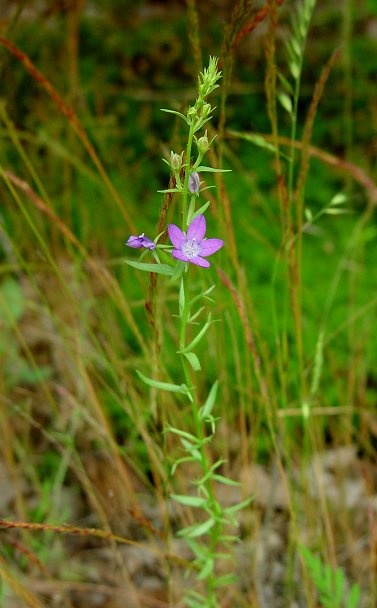Triodanis leptocarpa (Nutt.) Nieuwl.
Slender-Leaved Venus' Looking Glass

Native
CC = 5
CW = 5
MOC = 28
© DETenaglia
Triodanis leptocarpa (Nutt.) Nieuwl.Slender-Leaved Venus' Looking Glass | |
 |
Native CC = 5 CW = 5 MOC = 28 |
© DETenaglia |
|
Family - Campanulaceae Habit - Taprooted annual forb with milky sap. Stems - Sprawling, ascending, or erect, to 70 cm, simple, angular, short-hairy or roughened along the angles, to 3 mm thick. Leaves - Alternate, simple. Basal leaves narrowly elliptic to oblanceolate, tapered to a short-petiolate base, rounded or bluntly pointed at the tip. Stem leaves 8-25 mm long, 1-6 mm wide, 5-10 times as long as wide, linear to narrowly elliptic or lanceolate, sessile or very short-petiolate, tapered at the base, bluntly to sharply pointed at the tip, the margins entire or very finely scalloped or bluntly toothed, the upper surface glabrous or nearly so, the undersurface finely roughened or with stiff, short hairs.
Inflorescence - Solitary axillary flowers or small axillary clusters of 2-3, mostly very short-stalked, the leaves subtending flowers essentially indistinguishable from the often relatively few foliage leaves, the whole inflorescence appearing spicate. Flowers at most nodes mostly cleistogamous but normal, open flowers usually 1 or more per node along the upper 1/3-1/2 of the stem.
Flowers - Calyces with the tube 8-14 mm long, not inflated, the 5 lobes in normal flowers 5-10 mm long, narrowly triangular to narrowly lanceolate or linear, those in cleistogamous flowers 2-5 mm long, narrowly triangular to linear. Corollas in normal flowers bluish purple to purple, the 5 lobes 4-7 mm long, 1.5-3.5 mm wide. Stamens 5, adnate at base of corolla tube, alternating with lobes. Filaments purple, 1.5 mm long. Anthers yellow, filiform, 2-3 mm long, connate around style and stigma, curling when mature and dehiscing. Style 1, 7 mm long, glabrous, white below, purple above. Stigma 2-lobed. Ovary inferior.
Fruits - Fruits of two different types, those developing from the normal, open flowers straight and strongly ascending, 15-25 mm long, 1.3-1.8 mm wide, the 1(2) pore(s) 1.4-2.5 mm long, oblong-elliptic to narrowly oval, positioned at the tip of the fruit; those developing from the cleistogamous flowers twisted and/ or arched away from the stem, 5-18 mm long, 0.7-2.5 mm wide, with slender, longitudinal slits (alternating with the calyx lobes) above the midpoint or 1 pore 1.4-2.5 mm long, oblong-elliptic to narrowly oval, positioned at the tip of the fruit. Seeds 0.8-1.2 mm long, elliptic, somewhat flattened (moderately biconvex), the surface smooth, shiny.
Flowering - May - August. Habitat - Prairies, glades, bluffs, streambanks, pastures, roadsides, and open, disturbed areas. Origin - Native to the U.S. Lookalikes - Other species of Triodanis. Other info. - This species of Triodanis is quite distinctive in appearance due to its narrow leaves and relatively long, narrow fruits. These features make it easily distinguished from other members of the genus. In Missouri the plant occurs in a number of counties, mostly toward the western side of the state. In the continental U.S. the plant ranges in a curved arc from Montana, through Missouri, to the Texas border with Mexico. Photographs taken at Dave Rock Conservation Area, St. Clair County, MO., 5-12-00 & 6-7-03 (DETenaglia); also near Cedar Fourche, AR, 5-5-2015, and at Blue River fishing and hunting reserve, Johnston County, OK, 5-25-2023 (SRTurner). |